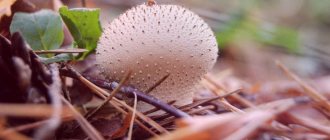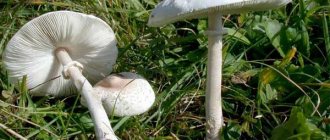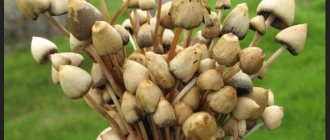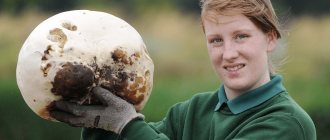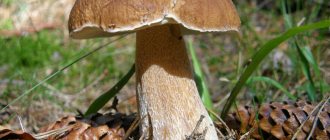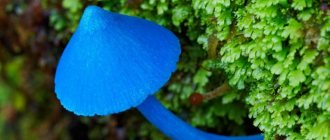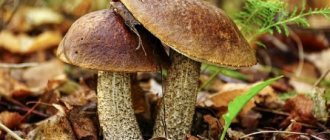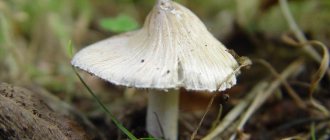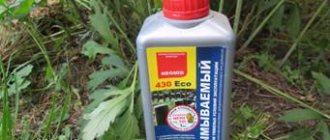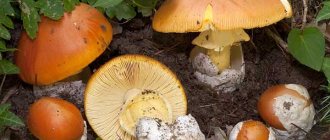Oyster mushroom (lat. Pleurotus ostreatus) is also called oyster mushroom or gliva mushroom. Refers to edible mushrooms. For a long time, it was not paid attention to from a fishing point of view. It gained its popularity after the food market was saturated with oyster mushrooms, which were grown on an industrial scale.
This mushroom combines high taste, fertility and low requirements for cultivation than champignons. Oyster mushrooms are found not only on store shelves, they also grow in nature.
The fungus is capable of causing yellow mixed rot in deciduous and coniferous trees. The fruiting body prefers to live in places with the greatest accumulation of rot. The dead tree makes a great home for him.
What does it look like
The mushroom cap reaches sizes up to 15 cm, and sometimes up to 20. The hat is round in shape, the edges are turned up, the appearance resembles an oyster shell. The cap is distinguished by a dense, dry, elastic structure, smooth, matte, bluish-gray skin. It turns white when wet weather sets in.
The spore-bearing layer is lamellar. The plate is white, but the old mushroom is most often yellow or gray. The color of the spore powder is white.
The leg reaches a length of 5 cm, can be cylindrical, most often curved.
The pulp is elastic and has no voids. The leg is painted white.
Preparing the substrate for oyster mushrooms
Substrate is a nutrient medium for the development of fungus. As in nature, plant residues, for example, sawdust, are selected. Some people take straw, or husks from sunflower seeds.
In nature, the fungus avoids them, since the “territory” is quickly occupied by mold. Growing oyster mushrooms on sawdust or straw in an artificial environment allows you to block the development of a pathogenic environment.
Typically, disinfection consists of hot steam treatment or soaking the substrate in boiling water for 2 hours. In the latter case, the container with plant raw materials is covered with plastic film.
You can get rid of mold spores using dietary supplements. They are commercially available, but do not exclude heat treatment. In other words, drugs are only an auxiliary method of disinfection necessary for the successful development of mycelium. Growing oyster mushrooms begins with its addition to the substrate.
Mycelium is called mycelium, that is, an underground body. From a scientific point of view, this is a mushroom. By the way, you can also eat and drink it. Remember kombuchas? So this is mycelium in a nutrient medium. Oyster mushrooms, however, have more valuable fruits. This is what scientists call the upper part of the “structure.”
growing oyster mushrooms in a basement or other room by growing mycelium. It's being sold. However, it is difficult to check the quality of purchased mycelium. The price and the minimum sales volumes are also confusing. Usually, a hundred mycelia are needed, but only 500 are ready to be “shipped.”
Mycelium is grown from fungal spores or pieces of it. The last method is called vegetative. The first technology is akin to adding seeds to the soil. The soil, by the way, is cereal grains.
This is an excellent growing medium for oyster mushrooms. When its mycelium takes root and begins to grow, it is time to transfer it to permanent soil. By the way, grains are also added to it. It is customary to take available pearl barley. Lightly boiled, it becomes a fertilizer mixture of straw, sawdust, and branches. They are shaped into mushroom blocks.
Sawdust or seed husks can be used as a substrate for oyster mushrooms.
How it spreads
The oyster mushroom mushroom grows in the temperate forest zone and loves deciduous and mixed forests. It prefers dead deciduous wood as a home.
It grows in groups, in kind of tiers of 30-50 pieces. The weight of the tier can be up to 2 kg. In September and October, oyster mushrooms are most fertile; if conditions are favorable, they appear in May.
Excellent for cooking, no pre-treatment is required for its preparation. It is easy to clean and stores well. As a rule, it is fried, boiled, stewed, canned, and also salted. Only the cap is used; the legs are unsuitable due to their high rigidity.
What time and how to choose correctly
The collection of mushrooms begins during the period of their active growth, so that the fruit falls on the beginning of autumn. When collecting mushrooms, it is necessary to pay attention to the size of the droplets. If the droplets are large, then this mushroom has already become overripe and has become unbearable before being harvested. It is necessary to cut the whole homeland, both small and large mushrooms. Friendly mushrooms still cannot survive without their great relatives. Cut with a sharp knife so that when cutting you do not damage the ball with mycelium. To collect crops, I prefer to wicker weave wide cats. This makes it possible to preserve the harvest without wasting its form.
Why are they useful?
- It is a low-calorie mushroom. It contains substances that can suppress appetite, which makes it an indispensable product in dietetics.
- It is perfectly absorbed by the body, the nutritional value is equal to meat products.
- Contains many proteins, fats, carbohydrates, B vitamins, and microelements.
- Rich in amino acids, contains a predominant amount of iodine and calcium.
- Oyster mushroom contains substances that can fight bacteria, which also remove radioactive substances from the human body.
- In folk medicine, a dry powder is made from it, which fights high cholesterol in humans.
Corysia power of glivi
This mushroom is a very strong anti-cancer product, although it is high in polysaccharides. The immunomodulating powers of this mushroom give a lipid influx to the growth of the chubby plant. It is recommended to take glyva after chemotherapy and radiation infusion, as this mushroom is good for removing toxins, cleansing our body from them. Currently, a lot of anti-cancer pharmaceutical preparations have been developed based on glive.
Until then, they have to take revenge:
- All vitamins of group B
- Nicotinic acid
- Vitamin C
- Vitamin E
- Zalizo
- Iodine
- Amino acids (tryptophan, threonine, phenylalanine, leucine, isoleucine)
- A number of minerals
- Monounsaturated fats
Why do you take glyva?
- For hypotension and hypertension;
- For the prevention of the disease of the sclero-intestinal tact
- Increased resistance of the body to viruses
- Zlabial effusion onto the intestinal stick;
- For diabetes, to reduce the level of glucose in the blood
- Reduced development of atherosclerosis;
- Prevention of cholecystitis;
- Control of parasites in combination with other antiparasitic approaches
- Renewal of the broken exchange of speeches;
- Prevention of diseases of the cardiac vascular system
It is important to place in your warehouse a large quantity of easily digestible protein, so that this product is equal in vital value to meat and dairy products. And since the mushroom has low fat content, it is wonderfully suitable for children’s food. Calorie content becomes approximately 37 kcal.
How to grow
Grows well in a substrate consisting of cellulose and lignin. Wood processing products are excellent as fertilizer. It is quite easy to grow oyster mushrooms at home. For breeding, high humidity - 95% and a small area are required. It can be grown on stumps, tree ferments, in a special substrate, or on a simple bag of straw.
The microclimate of the room where it is grown is of particular importance. The ideal place for growing is a well-ventilated basement.
Growing at home in a greenhouse and at the dacha in the garden
Growing oyster mushrooms yourself is easy and inexpensive. It needs a humidity of 80-95%, a temperature range from 9 to 25 ° C and very little area. On 1 m2 you can place 4-5 blocks of mushrooms, each of which will bear 2-3 kg of fruit 10 times a year. In fact, under such conditions, oyster mushroom grows on its own.
What mushrooms grow on is up to you to choose. Options include stumps, tree fragments, a special substrate, and even a simple bag of straw.
The most difficult thing is to create a microclimate. But if you don’t count on industrial cultivation of oyster mushrooms, but grow mushrooms for yourself, any stump on your property or a log dug into the ground that can be successfully integrated into the landscape will suit you. In a more complex scheme, a basement is ideal, which should be well ventilated, treated against mold, and equipped with fluorescent lamps.
The substrate for oyster mushrooms is, in fact, sawdust mixed with straw, buckwheat husks, corn leaves - with any plant residues. Proportions don't matter.
All this needs to be crushed, mixed, put in a vat, filled with water, boiled for 2 hours, and excess water drained. All that remains is to fill the suitable boxes and plant the mycelium (this is done at the same time).
REFERENCE! Now there are many options for purchasing oyster mushroom mycelium, both wholesale and retail. Do not buy it for future use: the mycelium is very delicate and lives only 5 days without planting.
Street stumps are sown at the end of April, covered with soil and covered with polyethylene. The mycelium is placed in cuts 5 cm deep, located at a distance of at least 30 cm from each other. Bags or boxes with the substrate are filled with a sawdust-straw mixture in layers: 5 cm of nutrient medium - half a centimeter of mycelium, and so on until filled. It is important not to forget to make small cuts in the container to release the mushroom blocks.
Wash your hands (or gloves) before sowing, warm the mycelium to room temperature before planting, and then success is almost guaranteed.
It can be hindered primarily by microclimate disturbances and the appearance of mold due to non-compliance with hygiene rules.
Immediate family
Oyster mushroom covered - the flesh is fleshy, dense, white, has a smell similar to raw potatoes. The edge of the cap is folded down. Inhabits Central and Northern Europe. This species is practically inedible. Oyster mushroom Oak - a cap up to 10 cm in size, convex in shape, white, cream or yellow in color, has a velvety structure. It can be eaten.
Oyster mushroom is horn-shaped - the cap has a concave or funnel-shaped shape. The flesh is white in color and has a powdery odor.
Oyster mushroom covered
Description:
Kapelushok
A droplet of this mushroom is fleshy. In young mushrooms, the shell becomes puffy, but as the mushroom matures, it becomes smooth, swelling into a shell like an oyster.
The surface of the droplet mushrooms is wobbly and shiny. At the beginning of growth, the droplets grow little from the bottom, but as they grow, they appear, swelling, as they said earlier, in the shape of an oyster.
Nizhka
The structure of the legs is thick and firm. It's thin at the top, but gets closer to the base. The place where the droplet is attached to the legs is not in the center, but slightly to the side.
Hymenophore
The cherry blossoms are hot, the legs are growing and the structure is being loosened. The color varies from white with a cream shade, to an ivory color or a gray shade.
Fruiting body of the mushroom
The fruiting body of the mushroom is thicker, more tender, medium-sized, white in color. The smell is pleasant, slightly anise. The mushroom does not have a strong mushroom aroma, one might say that it does not smell much better than the smell.
Forming mushroom blocks
Growing oyster mushrooms in bags is a popular method due to the compactness of production. As already mentioned, blocks can be arranged in several tiers. The shell is polyethylene. It is tightly filled with substrate and sealed. The block for oyster mushrooms is ready.
Growing at home or in a workshop begins with 16 hours of exposure at room temperature. Afterwards, the blocks are pasteurized at 80-100 degrees. Place the bags in boiling water. Close the lid and wait 2 hours. At home they boil in pots. In the gardens they use 200-liter barrels. Factories purchase special tanks.
After boiling, cool the substrate to 25 degrees and make cross-shaped cuts in the bags. In each of them we put a piece of mycelium. A teaspoon of mycelium is used per cut.
By the way, the slots in the bags do not exceed 5 centimeters in width. After inserting the mycelium, seal the holes with tape. We will remove it after 7 days, when the mycelium grows and sends out a web of white fibers through the substrate.
Its presence will be indicated by whitish spots near the slits sealed with tape. Having seen them, we make cuts in the tape. The standard width of the holes is 1 centimeter. This is enough for “bouquets” of oyster mushrooms to emerge. They will begin to appear in about a month.
